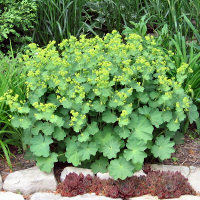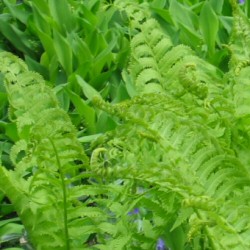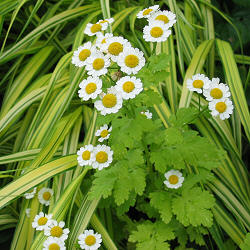GARDENS BY THE BAY

FOLIAGE PERENNIALS - A QUIET PRESENCE
Our gardens need plants with a quiet presence, a calming element where there is too much foliage variegation or bold flower or foliage colour. And nothing provides this element as well as solid-coloured foliage perennials. The foliage montage above shows just how much variety exists from one to another to provide interest with different colour tones and textures.
Most perennials have relatively short flowering periods, but foliage persists throughout the season. It need not be variegated, silver-toned, glaucous or otherwise unique to serve us well. Interesting habit or structure go a long way to giving our gardens pizzazz. All we need ask of the foliage is that it be attractive during the long period of time the plant it graces is out of bloom. The flowers, while they persist, are a beautiful bonus.
To prevent gardens from appearing so "busy" that our eyes won't know where to focus we need to search out foliage plants like the ones below, partnering them with suitable companions to enhance the effect they create.
* Watch for the animated hummingbird and butterfly with the plants that attract them. *
The deer icon indicates plants that deer are not usually attracted to.
   The best time and method to propagate plants can be found on our image-intensive PROPAGATION page.
To help your plants grow their best, check out our FERTILIZATION page.
To create your own plant partnerships based on tried and true color theory, check out our GARDEN COLOR page.
To see if a particular plant is on this page press Ctrl+F, type in the name, then click the Find button.
The best time and method to propagate plants can be found on our image-intensive PROPAGATION page.
To help your plants grow their best, check out our FERTILIZATION page.
To create your own plant partnerships based on tried and true color theory, check out our GARDEN COLOR page.
To see if a particular plant is on this page press Ctrl+F, type in the name, then click the Find button.
ALCHEMILLA
The pleated, deeply-lobed leaves of Lady's Mantle enchant everyone when they capture and hold moisture from rain or dew. Tiny chartreuse flowers appear in late spring and continue their bloom until early summer. Thereafter, the foliage of this one-foot-tall perennial is a wonderful presence in the garden, especially in the evenly moist, well-drained soil it prefers.
Alchemilla mollis: Lady's Mantle, 12-18"x30"

the foliage of this perennial can be seen in the border surrounding this page
synonym: Alchemilla vulgaris
seen in the image above over red Sempervivum tectorum
excellent to: tone down too much pink
where: near a pond, at border front, alongside a path, as a short perennial for problem areas
beside: Hosta 'Sum & Substance' or 'Gold Standard'
in shade with: Polygonatum odoratum 'Variegatum'
with: Achillea filipendulina 'Gold Plate' or 'Parker's Variety'
with: shrubs (esp. strong-coloured ones), roses, Buxus (Boxwood)
with: white, yellow, blue and purple flowers
with spring bulbs: species Crocus, other minor bulbs
with other moisture-loving perennials: Trollius, Primula denticulata 'Ronsdorf Mix'
in front of: Delphinium (a dark violet form), Thalictrum aquilegifolium, Verbascum chaixii 'Album'
with: Geranium 'Johnson's Blue', Ruta, Salvia, Iris sibirica (esp. violet shades), Primula polyanthes, Aquilegia
with annuals: Nigella damascena
with ornamental grasses: Festuca, Miscanthus sinensis 'Silberfeder'
with: Hosta including Hosta sieboldiana 'Elegans' and Hosta fortunei 'Obscura-marginata'
as edger beside: Nepeta x 'Six Hills Giant'
with: Lilium
in front of: Anemone tomentosa 'Robustissima', Campanula persicifolia (lavender-blue or white)
in front of: Phlomis russeliana (Jerusalem Sage) which also has excellent foliage presence when out of bloom
for foliage contrast with: Hosta, ferns, Astilbe, Pulmonaria
with: Anthemis tinctoria, Astrantia major, Platycodon grandiflorua 'Sentimental Blue' (a 15" tall dwarf)
combined with: Nepeta x faassenii & Stachys byzantina
Alchemilla erythropoda: Dwarf Lady's Mantle, 6"x15-18", serrated leaf edges, excellent edging plant
watch for an image here in 2008
this is a smaller version of the plant shown above
BERBERIS
A spiny deciduous shrub with tiny rounded to cup-shaped flowers followed by brightly-coloured fruits, Barberry was long banned in Canada as it served as intermediate host to black stem rust of wheat, oats, barley and rye. Recently re-introduced and welcomed back with open arms, barberry can provide a wonderful colour accent to the garden in some of its forms as well as a wonderful companion for many different perennials.
Berberis thunbergii 'Atropurpurea': Barberry
FERNS
Ferns might well be the ultimate foliage plant, as they produce no flowers whatsoever. The effect they create is strictly from their size and the wonderful variation in foliages that different species produce. I keep promising myself to learn more about them and add several to my garden beds. So far I have only five, but as I acquire more and more shade that number may increase. Four of my ferns are pictured below.
Ferns: in general




in sun with: Iris x germanica, Iris sibirica, Lilium, Monarda didyma, Persicaria bistorta
in sun with: Paeonia lactiflora (Common Garden Peony), Phlox paniculata
taller species behind: Paeonia (red)
in moist soil with: Aconitum napellus, Astrantia major
in light to heavy shade with: Dicentra, including D. eximia esp. the white cultivar 'Alba', D. spectabilis
in part sun or shade with: Ajuga reptans esp. 'Silver Beauty'
with shade-loving plants: Phlox divaricata, especially the rich crystal blue 'Laphamii'
in sun or shade with: Campanula (low-growing), Dodecatheon meadia
in full sun to part shade with: Gentiana including G. asclepidea
in moist soil in sun or shade with: Mertensia virginica, Chelone obliqua
in woodlands with: Digitalis, D. ambigua (synonym: D. grandiflora - yellow-flowered), D. x mertonensis, D. purpurea
with woodlanders: Epimedium, Erythronium, E. dens-canis, Helleborus including H. niger
with other woodlanders: Polemonium caeruleum, Polygonatum odoratum
at pond edge with: Helenium autumnale
interplanted with bulbs: Endymion hispanicus (Scilla hispanica, both purple and white forms), Crocus
in front of: Bergenia cordifolia including 'Bressingham Ruby'
with spring-blooming plants: Anemone including Anemone blanda, Anemone sylvestris, Brunnera macrophylla
use to hide bare spots in dormancy of: Anemone nemerosa (Wood Anemone)
with late-blooming: Anemone hupehensis 'September Charm', Anemone x hybrida, especially white 'Whirlwind'
with: Campanula glomerata (deep purple or white), Carex glauca, Heuchera spp. including H. americana
with: x Heucherella alba 'Bridget Bloom'
foliage contrast with: Alchemilla mollis, seen in the border around this page
behind: Begonia grandis including B. g. spp. evansiana
in moist soil with: Filipendula including F. rubra, Ligularia dentata, Lobelia cardinalis, Lobelia siphilitica, Lysimachia including L. clethroides or L. nummularia 'Aurea', Monarda didyma 'Violet Queen', Primula
in wet areas with: Caltha palustris, Camassia leitchlinii 'Blue Danube'
in dappled shade with: Aquilegia including red and yellow A. canadensis, Astilbe including Astilbe x arendsii
in light shade in front of taller plants: Aruncus dioicus
in shade with: Hosta spp. including 'Golden Tiara', H. undulata
with variegated shade plants: Lamiastrum galeobdolon 'Variegatum', Lamium maculatum 'Golden Anniversary'
with wildflowers: Arisaema triphyllum (Jack-in-the-Pulpit), Arum italicum 'Pictum', Asarum canadense &europaeum
with shrubs: Cornus florida, Cornus kousa, Cornus mas, Hydrangea
combined with: Geranium (Cranesbill) & Scilla hispanica
GERANIUM
The foliage of plants in the genus Geranium is wonderful in its many variations. While there are a few Cranesbills with bolder variegation, most are almost solid-green in colour. The difference appears in the leaf shapes and sizes as well as subtle markings. As an added bonus, the foliage of most forms can be cut back after the first flush of bloom and will re-appear as fresh new foliage that will grace the garden until autumn when some even turn lush fall colours.
Geranium renardii: 12", full sun, early summer bloom, gray-green foliage

perhaps the foliage most likely to demand being touched, covered with fine hairs
For more information and images check out the links below.
HEUCHERA
  The
Primrose Path web site has much interesting information about this genus and the multitude of new hybrids that have been introduced in recent years. Many of the newer forms for eastern gardens have one of two basic foliage types: bronze-purple hues or green leaves with white or silver patches between their veins. All prefer sandy, neutral, well-drained soil and fertilization with manure or 5-10-5 fertilizer. Put them in a spot with light shade, divide them every three years to keep them flourishing and sit back and enjoy them for the entire gardening season.
There are many more Coral Bells species and cultivars on other Partnership pages on our site. Just follow the links below for lots of ideas about complementary or contrasting companions.
The
Primrose Path web site has much interesting information about this genus and the multitude of new hybrids that have been introduced in recent years. Many of the newer forms for eastern gardens have one of two basic foliage types: bronze-purple hues or green leaves with white or silver patches between their veins. All prefer sandy, neutral, well-drained soil and fertilization with manure or 5-10-5 fertilizer. Put them in a spot with light shade, divide them every three years to keep them flourishing and sit back and enjoy them for the entire gardening season.
There are many more Coral Bells species and cultivars on other Partnership pages on our site. Just follow the links below for lots of ideas about complementary or contrasting companions.
HOSTA
In the rush to add variegated Hosta forms to our gardens, we sometimes forget the more muted types. Although not as flashy as many others, they add a much needed calmness, to tone down the brighter, busier types or to add a soothing element of their own.
The links below will take you to two of our own pages with images of and information about this genus.
The sites below will take you away from ours, but are sure to provide a wealth of valuable information about the genus Hosta. Be sure to bookmark us if you want to find your way back here.
IRIS
The bearded Irises, Iris x germanica, have solid, spiky foliage which goes through an unattractive stage that prevents them from being a superb foliage plant to add interest throughout the gardening season. The Siberian Irises, on the other hand, have upright, slightly cascading foliage which remains attractive and adds an interesting vertical element to the perennial beds in which they reside. The flowers, for as long as they last, are stunning.
Iris sibirica: Siberian Iris, in general, regardless of specific colour

with: Astilbe x arendsii, Lythrum salicaria 'Morden Pink'
with tall plants: Baptisia australis, Crambe cordifolia
with mounding plants: Geranium spp. including Geranium clarkei 'Kashmir White', Nepeta
with: Papaver forms, Lilium, Lobelia siphilitica, Lysimachia including L. clethroides
with: Campanula (low forms) or taller Campanula glomerata 'Superba'
with bulbs: Muscari
with: Heliopsis, Coreopsis (later-blooming forms)
with: Heuchera (pinks), Heuchera 'Coral Cloud'
combined with: Amsonia & Paeonia
combined with: Bergenia & Paeonia
combined with: Geranium psilostemon & Thalictrum aquilegifolium
combined with: Filipendula hexapetala, Paeonia, Thalictrum & Geranium spp.
Iris sibirica: blue shades

with: Dictamnus albus purpureus, Geranium sanguineum 'Album', Geranium spp (pink or white shades)
combined with: Geranium psilostemon & Lilium (early pale yellow)
Iris sibirica: blue & purple shades
Iris sibirica: purple shades
in front of: Aruncus dioicus
Iris sibirica: violet shades
Iris sibirica: white
near: Geranium sanguineum 'Album', Papaver orientale (deep crimson)
Iris sibirica: white or purple shades
with: Geranium sanguineum (magenta)
Iris sibirica: blue, white or violet shades
with: Paeonia (pink or crimson shades)
Iris sibirica: almost any colour
with: Geranium sanguineum striatum (formerly G. s. lancastriense - a 12" alpine, pale pink with deep rose veins)
Iris sibirica 'Caesar's Brother': violet-blue
with: Geranium himalayense
Iris sibirica 'Dewful': mid-dark purple
combined with: Baptisia australis & Paeonia 'Bockstoce' (mid-range pink)
Iris sibirica 'Fourfold White': clear white
combined with: Anchusa, Hemerocallis flava, & Veronica 'Crater Lake Blue'
Iris sibirica 'Little White': white, 12"
combined with: Geranium 'Ballerina', Astrantia major & Heuchera 'Pluie de Feu' (cherry-red)
Iris sibirica 'Orville Fay': medium blue with darker blue veins, 36"
with: Phlox paniculata, especially pink but also most other shades as well
Iris sibirica 'Ruffled Velvet': violet
with: Paeonia suffruticosa 'Muramatsu Sakura' (very large double pink)
with: Papaver orientale 'Degas' (salmon-pink with dark veins)
For more information about Siberian Irises and an alphabetical list of many cultivars available in the blue range, follow the link to our Blue Perennials & Their Companions - 2 page.
For even more images and information, visit the
Aulden Farm Company page.
PAEONIA
Most people plant the Peony for its wonderful June blooms. But it is definitely an amazing foliage perennial as well. Before its buds begin to form and after all the blooms are gone, it provides an enduring green foreground or background for an incredible number of other plants. To keep it in top shape to last the entire season you absolutely must remove all dead or dying flowers. Then, when all blooming is over, you must also cut back stems to well below the foliage.
Whatever you choose from the hundreds of cultivars available, either in the Paeonia lactiflora (Garden Peony), Paeonia tenuifolia (Fernleaf Peony) or Paeonia suffruticosa (Tree Peony) species, this plant will reward you with a wonderful presence until late fall.
Paeonia: foliage alone
Follow the links below to find partnerhip ideas for a variety of Peony forms, both in and out of bloom.
RUTA
Rue is an herb that should be used more often in our perennial borders, in any of the cultivars more commonly available today. Given the moist, well-drained soil and full sun it prefers, the attractive ferny foliage will provide a wonderful contrast to everything around it.
Ruta graveolens 'Harlequin': Herb-of-Grace, 1-3', blue-gray sub-shrub, yellow flowers

uses: border edges, herb gardens, flower arrangements
foil for: gray-foliaged perennials
with: Alcemilla mollis
TANACETUM
Feverfew, with dainty white flowers above ferny, aromatic foliage is a short-lived perennial for full sun to partial shade in average, well-drained soil. Provide it with these basic needs and cut it back after the first flush of blooms to encourage repeat bloom. Propagate by cuttings or seed in early summer. Self-sown seedlings will pop up here and there, a welcome bonus in your garden.
Tanacetum parthenium: Feverfew, 2-3', medium green foliage
once known as: Chrysanthemum parthenium before re-classification
where: will perform well even in dry shade
never with: other small-flowered plants
generally with: bold flowers and foliage (as a filler)
with: Coreopsis grandiflora, Phlox paniculata, small Ornamental Grasses, Monarda didyma 'Marshall's Delight'
in front of: Heliopsis 'Gold Greeheart' & Regal Lilies
beside: Astilbe 'Fire'
with: Artemisia 'Powis Castle'
combined with: Achillea x 'Moonshine' & Platycodon grandiflora
combined with: Campanula lactiflora 'White Flower Farm Selection', Digitalis ambigua & Phlox 'Miss Lingard' (white)
Tanacetum parthenium 'Aureum': Golden Feverfew, 6-8", chartreuse foliage

perfectly partnered in shade above with: Hakonechloa macra 'Aureola
with: Campanula poscharskyana, Chrysoganum virginiana, Rudbeckia spp.
Tanacetum parthenium 'Tetra White Wonder':
combined with: Asclepias incarnata 'Ice Ballet', Achillea 'Summer Shades Mixture' & Aquilegia 'Maxistar' (yellow)
All of our own Gardens By The Bay pages can be accessed by clicking on the links below.
HOME
GARDEN POETRY |
GARDEN POETRY MUSE
GEORGIAN BAY VIEW
BOTANICAL LATIN - BASICS
COLOR THEORY
THE GARDENS
CORNER GARDEN CONSTRUCTION |
CORNER GARDEN PLANTING |
LONG GARDEN
EAST GARDEN |
HOSTA GARDEN |
NORTH GARDEN |
WINTER GARDENS
PLANT PARTNERSHIPS
BLUE PERENNIALS Aconitum -
Geranium |
Iris - Vinca
BULBS Allium - Hyacinthus |
Narcissus only |
Tulipa only |
Minor Bulbs
BUTTERFLY MAGNETS Anaphalis - Hemerocallis |
Liatris - Veronicastrum
 DAYLILIES Spider & Unusual Form DAYLILIES Spider & Unusual Form EDGERS Arabis - Iris |
Nepeta - Veronica
FOLIAGE PERENNIALS
Alchemilla - Tanacetum
HOSTA Hosta - all
HUMMINGBIRD-FRIENDLY PERENNIALS Alcea - Salvia
ORANGE PERENNIALS Achillea - Tulipa
ORNAMENTAL GRASSES Acorus - Imperata |
Miscanthus - Spodiopogon
PINK PERENNIALS Achillea - Lilium |
Lychnis - Veronica
PURPLE PERENNIALS Aconitum - Liatris |
Polemonium - Veronica
RED PERENNIALS Achillea - Veronica
SHADE PERENNIALS Aegopodium - Erythronium |
Ferns - Polemonium |
Polygonatum - Vinca
SILVER FOLIAGE PERENNIALS
Achillea - Cerastium
|
Cornus - Limonium
|
Lunaria - Veronica
SIMPLY SPECIAL PERENNIALS Acanthus - Saxifraga
WHITE PERENNIALS Achillea - Iris |
Kalimeris - Yucca
YELLOW PERENNIALS Achillea - Hypericum |
Inula - Verbascum
VARIEGATED-FOLIAGE PERENNIALS Acorus - Erythronium |
Hakonechloa - Lysimachia |
Miscanthus - Yucca
PLANT PROFILES
Dianthus 'Tiny Rubies' |
Geranium |
Geum coccineum |
Kerria japonica |
Knautia macedonica
Paeonia tenuifolia |
Papaver somniferum |
Rudbeckia |
Salvia 'East Friesland'
Trollius |
Veronica 'Sunny Border Blue'
PROPAGATION
DIVISION - SPRING ONLY |
DIVISION - FALL ONLY |
DIVISION - SPRING OR FALL |
DO NOT DIVIDE
FERTILIZATION
EDGERS Arabis - Iris |
Nepeta - Veronica
FOLIAGE PERENNIALS
Alchemilla - Tanacetum
HOSTA Hosta - all
HUMMINGBIRD-FRIENDLY PERENNIALS Alcea - Salvia
ORANGE PERENNIALS Achillea - Tulipa
ORNAMENTAL GRASSES Acorus - Imperata |
Miscanthus - Spodiopogon
PINK PERENNIALS Achillea - Lilium |
Lychnis - Veronica
PURPLE PERENNIALS Aconitum - Liatris |
Polemonium - Veronica
RED PERENNIALS Achillea - Veronica
SHADE PERENNIALS Aegopodium - Erythronium |
Ferns - Polemonium |
Polygonatum - Vinca
SILVER FOLIAGE PERENNIALS
Achillea - Cerastium
|
Cornus - Limonium
|
Lunaria - Veronica
SIMPLY SPECIAL PERENNIALS Acanthus - Saxifraga
WHITE PERENNIALS Achillea - Iris |
Kalimeris - Yucca
YELLOW PERENNIALS Achillea - Hypericum |
Inula - Verbascum
VARIEGATED-FOLIAGE PERENNIALS Acorus - Erythronium |
Hakonechloa - Lysimachia |
Miscanthus - Yucca
PLANT PROFILES
Dianthus 'Tiny Rubies' |
Geranium |
Geum coccineum |
Kerria japonica |
Knautia macedonica
Paeonia tenuifolia |
Papaver somniferum |
Rudbeckia |
Salvia 'East Friesland'
Trollius |
Veronica 'Sunny Border Blue'
PROPAGATION
DIVISION - SPRING ONLY |
DIVISION - FALL ONLY |
DIVISION - SPRING OR FALL |
DO NOT DIVIDE
FERTILIZATION
BULBS |
ORNAMENTAL GRASSES |
PERENNIALS |
SHRUBS |
VINES
LINKS
GARDENS |
LOCAL GARDENS |
BOTANICAL TERMINOLOGY
GARDENING BOOKS |
NON-GARDENING
HOME
|
|
|